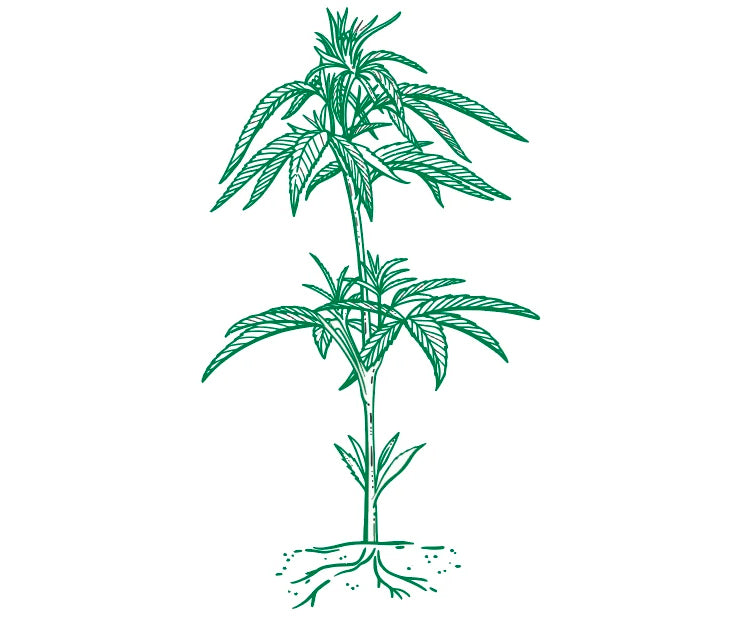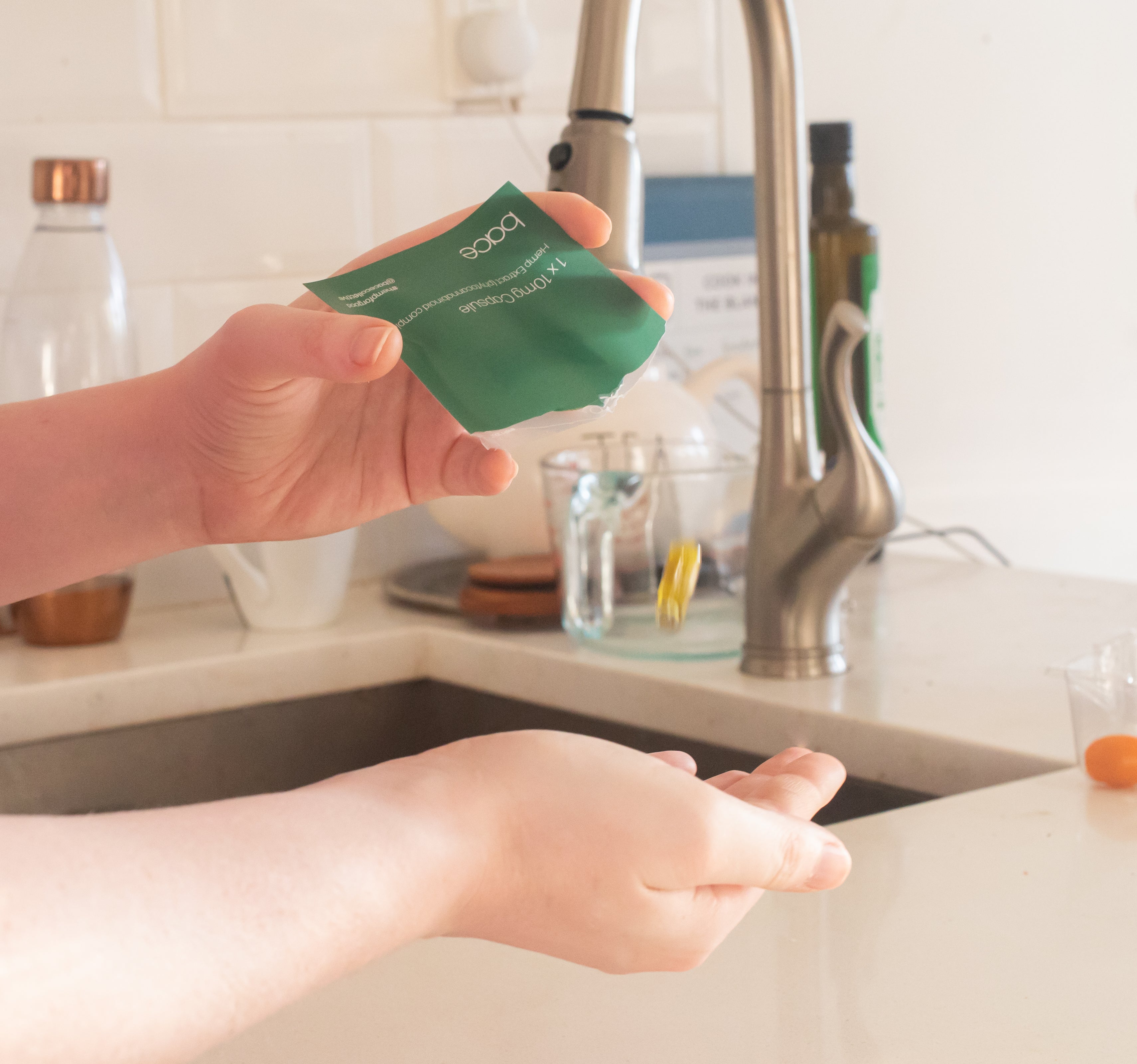[box]
Key Takeaways:
- Hemp (less than 0.3% THC), and Marijuana (more than 0.3% THC) are both parts of the the Cannabis Sativa plant.
- CBD is just one of many different phytochemicals in hemp extract.
- Hemp as a plant has many uses outside of extraction for cannabinoids. It is used as a source of cordage, textiles, paper, horticultural materials, and a potential source of biodiesel.
- Hemp has a deep history in the United States, and was previously a common part of society.
[/box]
What defines hemp?
Also known as “industrial hemp,” hemp is a specific type of Cannabis sativa (Cannabis sativa L.) Under federal law, dried hemp is required to contain less than 3% of tetrahydrocannabinol (THC), the cannabinoid compound responsible for the intoxicating effects of marijuana.
What is hemp used for?
Like all cannabis plant species, the anatomy of hemp features identifiable fan leaves, a sturdy stem, and flowering buds. But there’s much more to these plants than meets the eye. Every hemp plant’s stem contains bast fibers, shives (hurd), and within the plant’s flower structure contains smaller leaves, seeds, and small hair-like structures called trichomes.
When used to its full potential, every part of the plant is capable of industrial resources such as textiles, rope, building materials, and more. Industrial hemp also produces fatty acid oil from seeds and essential oils from the plant’s flowers and leaves. The resulting hemp oil contains over 100 natural cannabinoids and terpenes with nutritional sustenance and high-yielding fiber properties, making it an ideal ingredient for health food products.
What is hemp fiber?
Hemp fiber is an environmentally sustainable way to provide biodegradable products like cordage, textiles, paper, horticultural materials, and a potential source of biodiesel.Overall, the hemp plant’s stem contains three types of blast fibers that are organized by cell strength and cell wall thickness:
- Primary phloem: long blast fiber from the stem’s outer cells.
- Secondary phloem: shorter blast fiber from the stem’s inner cells.
- Xylem: short, woody core fibers.
Blast fibers sourced from the primary phloem are the most valuable type of hemp fiber because it's the longest. Hurds or shives are raw materials made from short fibers inside the stem that produce goods such as animal bedding, compost, particleboard, ceiling panels, and more.
What are hemp seeds?
Hemp seeds are cultivated from the plant's flowers and provide a rich source of dietary fiber, proteins containing amino acids, carbohydrates, vitamins, and minerals. But unlike the rest of the plant, hemp seeds do not contain cannabinoids.
People often ground up hemp seeds to make hemp meal or flour, hemp seed milk, or protein powder. However, hemp grain is primarily known for its optimal ratio of omega-6 and omega-3 fatty acids found in hemp oil.
What is hemp oil?
Industrial hemp produces three types of hemp oils: cannabinoid oil, essential oil, and hemp seed oil. As a whole, hemp extract contains over 100 different terpenes and cannabinoids, protein, fatty acids, and several other vitamins and minerals. When consumed together, cannabinoids and terpenes work synergistically to create "the entourage effect."
What’s the deal with CBD oil?
Although it's medicinal research is limited, cannabidiol (CBD) oil has quickly become a household name for its claim to promote relaxation and relieve pain. Many people purchase CBD products–– which are frequently labeled as “hemp oil” or “full-spectrum hemp extract”–– in the form of oil tinctures, food products, vape devices, or capsules.
But what many people don’t realize is that CBD oil contains more cannabinoids than CBD. Depending on the product, non-intoxicating phytocannabinoids like cannabichromene (CBC) and cannabigerol (CBG) are also present in various concentrations.
It’s important to include other cannabinoids within CBD extract because research supports that CBD interacts with our bodies more effectively in the presence of other cannabinoids and terpenes. The synergistic relationship between hemp’s molecular compounds and our body’s ability to interact with them favorably is called the entourage effect.
But unlike marijuana's most famous cannabinoid, THC, cannabidiol doesn't produce any psychoactive effects. CBD might make you feel less anxious or sleepy, but the worst-case scenario is not feeling anything at all.
How is hemp different from marijuana?
Our understanding of the word "hemp" is largely dictated by legal definitions, which don't always provide the clearest explanation of the plant itself. In short, the legal definition of "hemp" is any product of C. sativa L. that contains less than 0.3% of delta-9-tetrahydrocannabinol (THC) in dry weight. If C. sativa L. contains more than 0.3% THC, it's "marijuana." Anything less is called hemp.
The sweeping change to hemp’s legal definition occurred through the Farm Bills of 2014 and 2018, which allowed the U.S. Food and Drug Administration (FDA) to begin regulating industrial hemp production for consumer goods–– not recreational marijuana use.
As a result, hemp was removed from the definition of “marihuana" on the Controlled Substances Act and is now recognized by the United States Department of Agriculture's (USDA) as a "commodity" used for "industrial and horticultural purposes," such as textiles, paper, food, construction materials, and cannabinoids.
If hemp is cannabis, why isn’t it marijuana?
The 2018 Farm Bill removed the word “hemp” from the definition of “cannabis,” a Latin term for the genus of all C. sativa L. plants–– which include Cannabis Indica Lam and Cannabis ruderalis Janisch subspecies. According to this logic, the word "cannabis" is any cannabis plant with unknown concentrations of THC. Once the concentration is known, the plant is either hemp or marijuana.
Is it scientifically accurate to exclude hemp from the definition of Cannabis? Not really. But the definition change is important for navigating the legality of hemp with the U.S. Department of Justice. If you asked the U.S. Drug Enforcement Administration (DEA) what “cannabis” meant to them, you’d be directed to a list of Schedule I drugs–– right next to heroin, peyote, LSD, and ecstasy.
According to the DEA, the classification of “Schedule I” drugs assumes that the substance lacks medicinal value and poses a high risk for drug abuse. What this means is that the federal government recognizes the benefits of hemp, both agriculturally and medicinally. The main stipulation against cannabis is THC content.
Cue the term “industrial hemp”
To avoid confusion surrounding the difference between hemp and marijuana, many people opt for the word "industrial hemp" instead. Industrial hemp is cultivated for fiber, oilseed, and grain–– not medicinal or recreational drug purposes.
The seedy history of hemp in the United States
If you couldn’t tell already, industrial hemp has had a long journey to commercial legalization in the United States. But life wasn’t always so difficult for hemp.
Back in the 1600s’, colonial settlers widely endorsed growing cannabis to produce hemp paper, rope, and textiles. Colonialists loved hemp products so much that in 1619, the Virginia Assembly required all farmers to grow hemp. According to PBS, hemp was an acceptable form of money in states like Maryland, Pennsylvania, and Virginia.
And thanks to George Washington, who frequently wrote about his love of the plant, hemp cultivation became a significant cash crop for several state economies. Everybody loved hemp: Thomas Jefferson, James Monroe, Andrew Jackson. Even Franklin Pierce supported hemp, and he hated everything.
After the American Civil War, cheaper fibers replaced hemp in specific markets, but the hemp industry maintained its popularity in the U.S. until the early 20th century. By then, anti-drug propaganda began circulating in response to the Mexican Revolution of 1910. Marijuana quickly became associated with xenophobic and racist attitudes against immigrants, leading all but 21 states to outlaw marijuana by 1931.
But discriminatory practices didn’t curb the hemp industry where it was allowed. Despite the 1936 movie release of Reefer Madness, hemp was still on the verge of becoming a “billion-dollar crop.”
It wasn't until DuPont, a synthetic textile company, joined lumber companies in lobbying for the "Marihuana" Tax Act of 1937 that the hemp industry took a turn for the worse. The resulting law made the possession of marijuana illegal without an additional paid tax, and the person in possession had the authorization to use cannabis for industrial uses.
Despite the wreckage of the 1930s', hemp made a massive comeback during World War II. Japan's attack on Pearl Harbor in 1941 stunted commercial trade over the Pacific, restricting the American military from foreign goods. Products such as abaca fiber were no longer available to make rope, and hemp was no longer widely produced to make uniforms and canvas.
To make up for the short supply, the DEA released the 1942 short film Hemp for Victory to inspire farmers to grow hemp as a patriotic duty. Hemp farming was so valuable at the time that the military provided hemp farmers with draft deferments. By the end of 1943, said farmers grew 375,000 acres of hemp total.
Unfortunately, hemp's comeback didn't last after WWII. For decades following the 1950s', all Cannabis sativa plants were illegal to grow. It wasn't until 2014 that the U.S. Senate passed the Farm Bill, which allowed authorized pilot agencies to experiment with the many uses of hemp once again.
In 2018, the Farm Bill completely decriminalized growing industrial hemp and allowed the USDA’s Agricultural Marketing Service to begin regulating hemp’s production on a larger scale.
Sources
Abernathy, A. “Hemp Production and the 2018 Farm Bill.” Congressional Testimony, Food and Drug Administration, July 25, 2019. Link.
Agricultural Marketing Service, USDA. “Establishment of a Domestic Hemp Production Program.” Federal Register, The Daily Journal of the United States Government, Oct 31, 2019. Link.
Buckley, C. “Hemp produces viable biodiesel, UConn study finds.” UConn Today, University of Connecticut, Oct 6, 2010. Link.
“Drug Scheduling.” United States Drug Enforcement Administration, U.S. Department of Justice, n.d. Link.
Hudak, J. “The Farm Bill, hemp legalization and the status of CBD: An explainer.” The Brookings Institution, Dec 14, 2018. Link.
Jeliazkov, V.D., et al. “What is Industrial Hemp?” Oregon State University Extension Service, Oregon State University, Aug 2019. Link.
“Marijuana Timeline.” Frontline, Public Broadcasting Service, 2014. Link.
Robinson, Rowan (1996). The Great Book of Hemp: The Complete Guide to the Environmental, Commercial, and Medicinal Uses of the World's Most Extraordinary Plant. Rochester, Vermont: Park Street Press. p. 131. Link.
“The People’s History.” The Thistle, Vol. 13, No. 2, Massachusetts Institute of Technology, 2000. Link.
“Title 21 United States Code (USC) Controlled Substances Act.” Drug Enforcement Administration, U.S. Department of Justice, n.d. Link.
USDA, (1942). “Hemp for Victory.” Hemp Industries Association, YouTube, Dec 14, 2015. Link.





